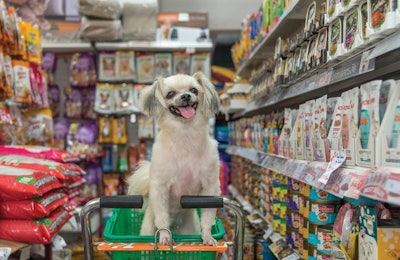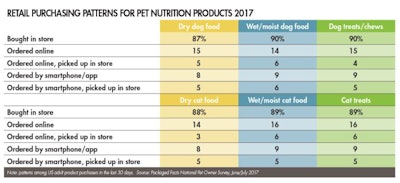
As Packaged Facts said in US Pet Market Outlook (May 2017), the internet is the new “pet parent,” as a dramatic force reshaping the market landscape. E-commerce has accelerated its shift from being a Wild West boomtown toward becoming the market’s retail California, USA. M&A activity since 2016 — including Mars’ purchase of VCA Inc. and other veterinary practice consolidation, PetSmart's acquisition of Chewy.com and Walmart’s acquisition of Jet.com — all point to a structural remix of the pet market.
Amazon’s strategy in an online/physical world
Given that supermarkets account for nearly a fifth of US pet food sales, to that list should be added Amazon’s plan to pay nearly US$14 billion to acquire leading natural foods marketer Whole Foods Market. Amazon’s interest in entering the brick-and-mortar grocery business is clearly part of its overall goal of selling everything to everyone, including pet owners. As Petfood Industry has noted, pet food is important to Amazon sales — and vice versa.
But Amazon, while very much internet-based, is not confined to that shopping superhighway. Amazon is already experimenting with its own brick-and-mortar concepts, including AmazonFresh Pickup, which allows shoppers to buy items online and choose a time to collect them at a drive-in Amazon facility, where the grocery bags will be brought to their car. This service is in line with several order and pick-up systems initiated by other supercenter and grocery chains.
The Whole Foods acquisition takes that up several notches by combining pick-up locations with one of the best retail grocery shopping experiences in the business. As the Wall Street Journal (June 17) reported, Whole Foods would expand Amazon’s “neighborhood network” of urban warehouses at least fivefold, giving Amazon compact urban distribution nodes in major markets nationwide.
The complexity of the online shopping revolution
This dimension of Amazon’s planned purchase of Whole Foods raises an easy-to-overlook point about the online shopping revolution: it can be clicks-and-back-to-bricks again. Among pet product shoppers who are active internet users, as indicated by a June–July 2017 Packaged Facts national pet owner survey, 3–6 percent of online purchases of dry pet food, wet pet food or pet treats are subsequently picked up at the store, and that ratio rises to 8–9 percent in the case of smartphone or tablet app purchases of these pet nutrition products (see Figure 1). Factor in that 43 percent of millennials age 18–34 are purchasing pet products through smartphone or tablet apps, against only 13 percent of boomers and seniors age 55+.

FIGURE 1: The internet has provided more opportunity than ever for customized pet product purchasing, and customers are taking advantage of the many ways they can now shop for their pets.
Add to that the fact that on a monthly basis, even among active internet users, a far higher share of pet owners are buying dog or cat nutrition products in-store, at 87–90 percent, compared with online, at a 14–16 percent rate, even when including online purchases that are completed through in-store pick-up.
While the moral isn’t that everything old is new again, it bears remembering that — particularly with something as elemental as food, human or pet — revolutions reconstruct far more than they fully replace. Particularly in metro areas, and especially among the millennials who now set market trends, local store pickup options will emerge as an important-to-consumers differentiator to the overall pet product shopping experience, and thus as a contributor or inhibitor to store loyalty. Drive-thrus are a time-honored and market-tested option for retailers bedecked with asphalt, but that will be the exception in crowded urban neighborhoods. In-vehicle delivery presents another option, but requires faultless execution (staffing, timing, text alerts, coupon tie-ins, loyalty points, free gifts with purchase) to win over American consumers who are as averse to sitting parked in cars as they are fond of driving them.
In an era when retailers and e-tailers are increasingly hard-pressed to differentiate on product selection, pricing or promotion, what happens in-store or store-side with the “last 100 feet” of product pickup will help determine the winners in the new (r)etail era.
More Packaged Facts research on the US pet market
















